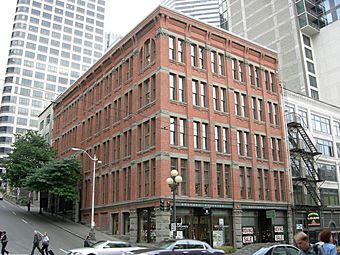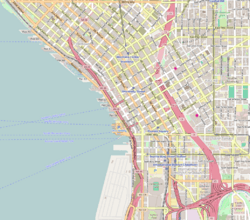Holyoke Building facts for kids
|
Holyoke Building
|
|

The Holyoke Building, September 2007
|
|
| Location | 1018-1022 1st Ave., Seattle, Washington |
|---|---|
| Built | 1889-90 |
| Architect | Bird, Thomas G.; Dornbach, George W. |
| Architectural style | Victorian Commercial; Romanesque |
| NRHP reference No. | 76001888 |
Quick facts for kids Significant dates |
|
| Added to NRHP | June 3, 1976 |
The Holyoke Building is a historic building in downtown Seattle, Washington. It is a large, five-story brick building with stone decorations. Its construction started just before the Great Seattle fire of 1889. The building was finished in early 1890. This made it one of the first new buildings ready for use after the big fire.
Today, the Holyoke Building is one of the few original buildings left in Seattle outside the Pioneer Square area. It shows how Seattle's business district grew north after the fire and before the Klondike Gold Rush in 1897.
Over the years, the Holyoke Building was home to many social and artistic groups. In 1895, it had the Conservatory of Arts on its top floor. Later, in the 1920s, the Seattle Musical Club met there. Many local artists and musicians gathered in the building. Other private clubs also shared the space with offices and businesses.
The Holyoke Building shows a calm example of the Victorian Commercial style, with parts of the Romanesque style. It looks almost exactly as it did when it was built. Even its storefronts, which were changed over time, have now been restored. This building is the only known work by architects Thomas Bird and George Dornbach. Their partnership ended before the building was even finished. After its restoration in 1975, the Holyoke Building was added to the National Register of Historic Places in 1976. It became a City of Seattle Landmark in 1978.
Contents
History of the Holyoke Building
Building After the Great Fire
The Holyoke Building is named after Richard Holyoke (1836–1905). He came to the Puget Sound area in 1860 from New Brunswick, Canada. He wanted to join the growing timber business. He helped start the mills in Seabeck. His business was very successful. Even after the Seabeck mills burned down in 1886, he kept buying lots of property in Seattle. This showed he believed in the city's future.
Richard Holyoke became a well-known person in the community. He was a big supporter of local lumber. He was also the treasurer of the Farmers' Insurance Company. He started and became the first president of the National Bank of Commerce in Seattle. This bank later became Rainier Bank, one of the biggest banks in the region.
Richard Holyoke had owned the land at First Avenue and Spring Street since the early 1880s. Before the Holyoke Building, the Puget Sound Iron Works was there. By 1888, those old buildings were empty and falling apart. Holyoke wanted to build something new, but bricks were hard to find and expensive.
Construction on the Holyoke Building finally began in the spring of 1889. The building was designed by Seattle architects Thomas G. Bird and George W. Dornbach. They worked together for a short time in 1889. When the Great Seattle Fire happened, workers were digging the foundation. This large pit actually helped stop the fire from spreading further north.
The building was first planned to be four stories tall. But after the fire, the plans were changed to make it five stories. Construction moved quickly. Local newspapers soon called it "one of the largest buildings in town." The ground floor had two storefronts facing First Avenue. Because the land sloped, a third storefront was at the back of the building on the second story, facing Spring Street. The upper floors were designed for offices.
Richard Holyoke faced money problems after the Panic of 1893. He sold all his Seattle property, including the Holyoke Building. He moved to Skagit County where he had a large farm. He passed away in 1905 in Bellingham.
In November 1900, Anton Stander bought the building. He had become rich during the Klondike Gold Rush. Stander's wife later sued him for the building during their divorce. Sometimes, it was hard to fill all the office spaces. So, later owners rented out whole floors to businesses. The Northwest Fixture & Electric Company, which sold electric motors to miners, used the upper floors from 1894 to 1900. J. Kobi & Company made toiletries on the fifth floor until 1923.
By the early 1900s and into the 1920s, the Holyoke Building became a popular place for Seattle musicians and artists. In 1902, Nellie Cornish opened her studio there. She later started an arts school in Seattle, now called Cornish College of the Arts. Many artists, musicians, and drama teachers worked in the building. The Robert Morris Social Club held dances there. The Seattle Musical Club also met in the building for practice and discussions about music. Other social clubs, like the "Lonesome Club," also opened in the building.
Restoration and Modern Use
Over the years, the building's outside look changed very little. Some storefronts were updated, and a fire escape was added. But these changes have since been removed. After the 1949 Olympia earthquake, most of the granite that decorated the top of the building was taken off.
In 1975, the Holyoke Building was added to the National Register of Historic Places. Its owners, Harbor Properties, decided to renovate it. This project cost nearly $1 million. The goal was to turn the mostly empty building into a lively mix of offices and shops. The architects planned to create a large indoor courtyard inside the building. This was a new type of project for Harbor Properties, which was known for tearing down old buildings.
Today, the Holyoke Building is home to the Seattle branch of WeWork. This company provides shared office spaces for different businesses and people.
Images for kids




